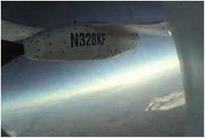Departure from Controlled Flight (6G)
The focus of the test flight program now began to shift to prepare for the upcoming rocket-powered flights. Up to this point, SpaceShipOne was flown light, but for rocket-powered flight, it would have to maneuver with a fully fueled rocket engine. SpaceShipOne was loaded so the center of gravity (CG), or the single balance point of SpaceShipOne s mass, moved to the aft to simulate these conditions.
When Melvill tested the stall characteristics for the aft-loaded SpaceShipOne, the nose swung upward uncontrollably before the wings reached the angle of attack at which they were expected to stall. SpaceShipOne entered into a spin while Melvill fought to regain control. Figure 7.7 shows SpaceShipOne as Melvill recovered from the tail stall.
“We had a pretty significant departure from controlled flight at high angle of attack, aft CG, due to a tail stall. That really was a big surprise,” Doug Shane said.
Г
Flight Test Log Excerpt for 6G
Date: 23 September 2003
Flight Number Pilot/Flight Engineer
SpaceShipOne 6G Mike Melvill
White Knight 37L Pete Siebold/Matt Stinemetze
and Jeff Johnson
Objective: Third glide flight of SpaceShipOne. Aft CG flying qualities and performance evaluation of the spaceship in both the glide and reentry or "feather" mode. Glide envelope expansion to 95 percent airspeed, 100 percent alpha [angle of attack] and beta [sideslip angle], and 70 percent load factor. More aggressive post-stall maneuvering and spin control as a glider and while feathered. Nitrous temperature control during climb to altitude and performance of upgraded landing gear extension mechanism and space-worthy gear doors.
(source: Mojave Aerospace Ventures LLC, provided courtesy of Scaled Composites)
4___________________ J
Г ‘
Fig. 7.6. After quickly correcting the avionics malfunction, SpaceShipOne and White Knight returned to the air several hours after the aborted fourth test flight.
During this flight test, SpaceShipOne extended its feather for the first time. It performed superbly. Mojave Aerospace Ventures LLC, photograph by David M. Moore
v____ J

Г

![]() Fig. 7.7. The sixth glide flight, on September 23, 2003, focused on the handling qualities when SpaceShipOne was loaded in the back, where the heavy rocket engine would eventually be. SpaceShipOne stalled unexpectedly, and the photograph shows the craft right after recovery.
Fig. 7.7. The sixth glide flight, on September 23, 2003, focused on the handling qualities when SpaceShipOne was loaded in the back, where the heavy rocket engine would eventually be. SpaceShipOne stalled unexpectedly, and the photograph shows the craft right after recovery.
Mojave Aerospace Ventures LLC, video capture provided courtesy of Discovery Channel and Vulcan Productions, Inc.
ч___________________________________________________________________________________ У
The feather wasn’t raised during the test flight, but during the climb to release altitude, the pressure test of the oxidizer tank revealed a variation of less than 6 psi. This meant that the temperature of the nitrous oxide inside could be controlled very well by exhaust air ducted in from White Knight.
Scaled Composites needed wind-tunnel data to evaluate the problem with the tail booms. “Except we didn’t have a wind tunnel, but we did have a pickup truck. And we had our aero guy, Jim,” Shane said.
Using a converted pickup truck fitted up with instrumentation, called the Land Shark, engineers aerodynamically tested mockups of the tail boom. With clearance from Mojave Airport, the Land Shark zoomed up and down a runway to collect data.
“We finally ended up doing a fence and a span increase on both the stabilizer and the elevon and resolved the problem,” Shane said.
A triangular strake was also added to each tail boom, right in front of each horizontal stabilizer. SpaceShipOne was ready to go back to flight testing.
r—————————————– Л
Flight Test Log Excerpt for 7G
Date: 17 October 2003
Flight Number Pilot/Flight Engineer
SpaceShipOne 7G Mike Melvill
White Knight 38L Pete Siebold/Cory Bird
and David Moore
Objective: Fourth glide flight of SpaceShipOne. Primary purpose was to examine the effects of horizontal tail modifications at both forward and mid-range CG locations (obtained by dumping water from an aft ballast tank between test points). The tail modifications included a fixed strake bonded to the tail boom in front of the stabilator and a span-wise flow fence mounted on the leading edge of each stab at mid-span. Other test objectives included a functional check of the rocket motor controller, ARM,
FIRE, and safing switches as well as the oxidizer dump valve. Additional planned maneuvers included full rudder pedal sideslips and more aggressive nose pointing while in the feathered configuration.
(source: Mojave Aerospace Ventures LLC, provided courtesy of Scaled Composites)
V___________________ J










